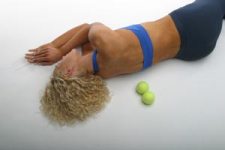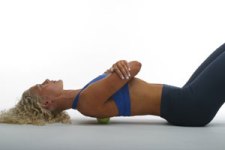The old adage “when you need a copper they are never around” often applies to getting some massage for tired sore muscles. When you most need a massage, you can never find someone to help out. This led the therapists at Wellness at Work and Bodywall to develop TBT (Tennis Ball Technique) a simple and effective way to self-massage TBT is now taught to therapists, athletes, people in recovery from serious injury, airline cabin crew builders with frozen shoulder, executives and mums wishing to download some stress.
First published in Fitness Life Magazine TBT is now published internationally and is in use by therapists around the world. Easy to learn and easy to do TBT allows you to access many hard-to-reach muscles yourself and, with a small amount of practice, get down to a 20-minute self-help routine that will leave you relaxed, smiling and ready for action.
This time we have TBT for the Rhomboids, a technique to help you get at those locked up back muscles, unwind, relax and leave that aching upper back pain behind. Once learned this is one you will never forget, especially after a busy day it’s a godsend.
In the same way that when you smile recruit patterns of muscles, depending on who you talk to somewhere between 13 and 17. Loads of muscles are recruited when we get into strong emotional states. The Rhomboids respond to grief so if you have been going through a hard time emotionally, you may want to go easy when you start this exercise, although once these muscles are undone the relief is fabulous.
This TBT exercise is great for easing painful conditions such as “Dowagers Hump” which gets worse as we age. Try doing this every day for a month and you will be delighted with the changes to your upper back posture. Plus when your shoulders go back to where they’re supposed to, it does wonders for your overall look as well.
With TBT more is more. The longer you leave muscles to relax the better the result. From at least 30 seconds and up to 60 seconds in each position is best. Don’t be too concerned if you get some clicks or “spontaneous adjustments” of the spine as muscles relax and vertebrae slip back into the right places its’ quite normal. 
Pic 1/ Lay on your side and place the tennis balls together side by side at 90 degrees to your spine at about mid back to upper back. Then using your feet to ‘steer’ yourself, roll the balls up and down your spine. This releases large amounts of tension and enables you to position the balls exactly where you feel sore. Slowly work your way down to the base of the spine and back up between the shoulder blades right back onto the Rhomboid muscles again.
Pic 2/ Slowly roll back onto both balls. The objective is to end up with one ball applying pressure to either side of the spine, and onto the erector spinae group of muscles that run either side from the base of the spine to the neck. Now stretch your arms out to the sides and relax for a minute or so.

Pic 3 a/ and b/ Gently grip each elbow then slowly lower and raise your arms through their entire range of motion. By using your feet and adjusting your arms you can gradually release all the tension in the mid / upper back region.
4. To get off the balls, always roll onto your side back to the start position. The spinal muscles are loose now so they need some time to relax, give them a moment and then slowly get up.
For more info contact www.wellnessatwork.co.nz
Read more from Chris Toal.









Join the Discussion
Type out your comment here:
You must be logged in to post a comment.